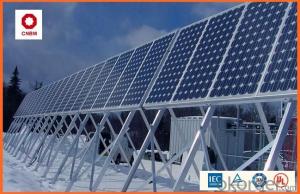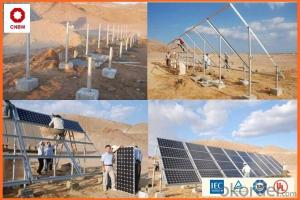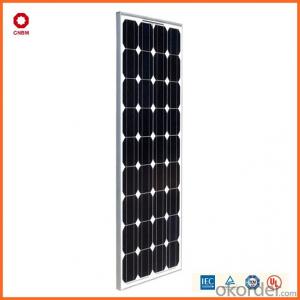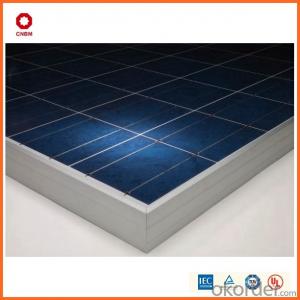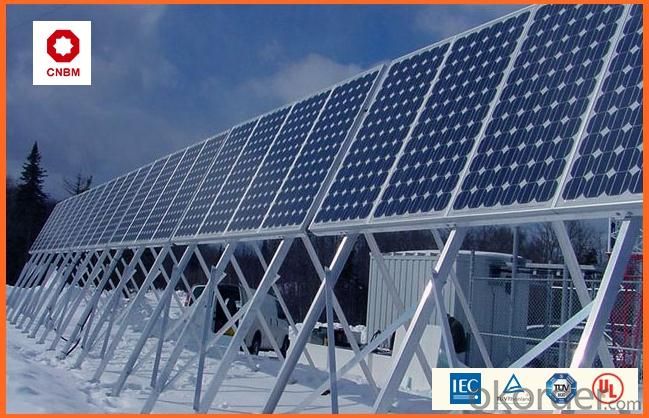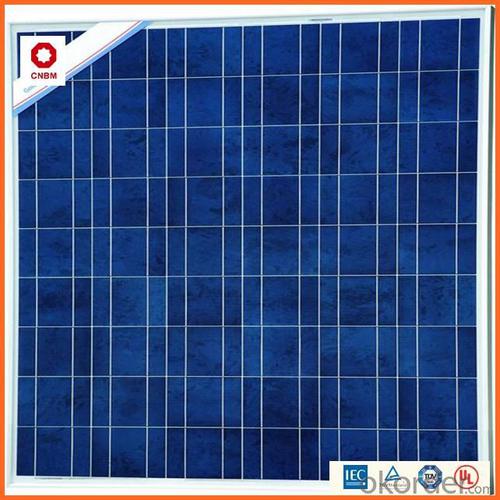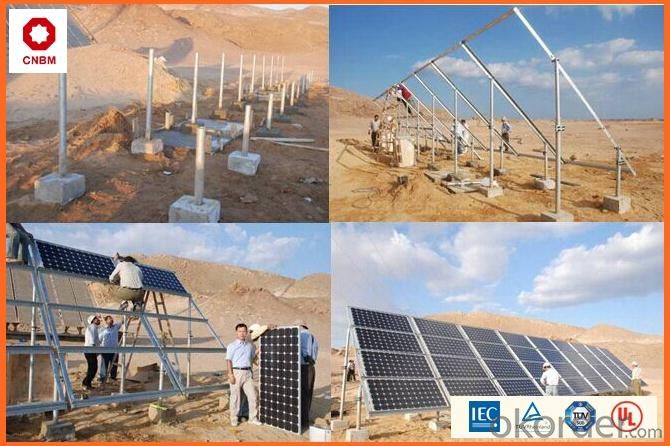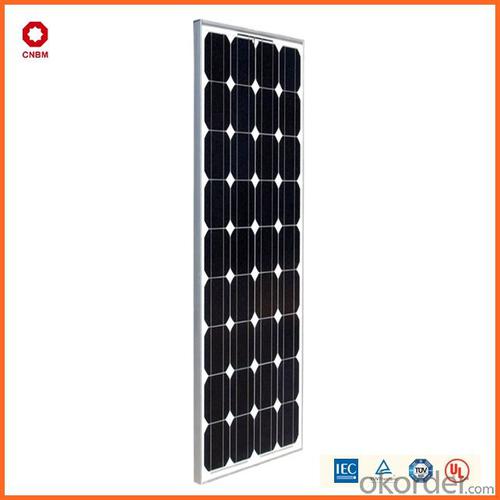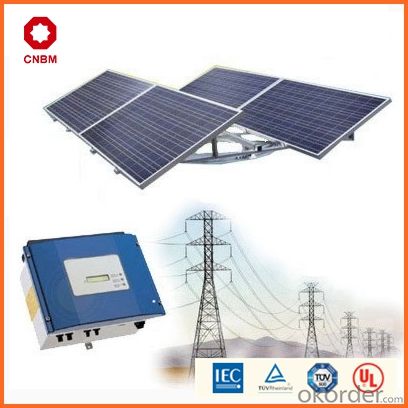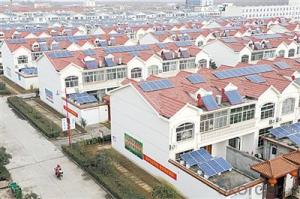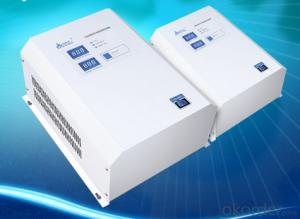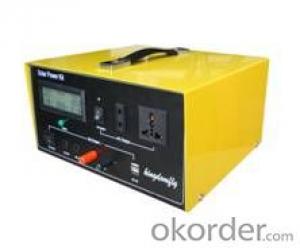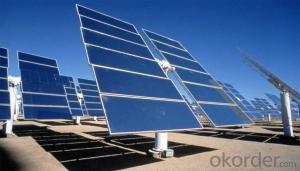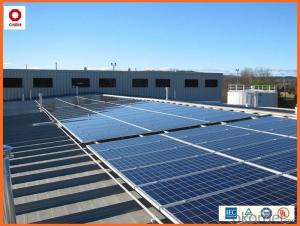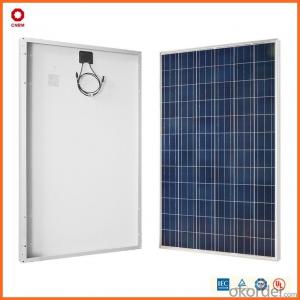Sirius Solar Energy Systems 105w Small Solar Panels in Stock China Manufacturer
- Loading Port:
- China main port
- Payment Terms:
- TT OR LC
- Min Order Qty:
- 1 watt
- Supply Capability:
- 10000000 watt/month
OKorder Service Pledge
OKorder Financial Service
You Might Also Like
Specification
Product Description:
Hot Sale !!! Quality and Safety of Small Poly Solar Panel 5w~150w
1. Rigorous quality control meets the highest international standards.
2. High-transmissivity low-iron tempered glass, strong aluminium frame.
3. Using UV-resistant silicon.
4. IS09001/14001/CE/TUV/UL
Warranties of Small Poly Solar Panel 35~85w
1. 10 years limited product warranty
2. 15 years at 90% of the minimal rated power output
3. 25 years at 80% of the minimal rated power output
Specification
Characteristics of Poly solar panels CNBM (245-320W) | |||||
Max Power Voltage Vmp(V) | 30.3 | 30.8 | 31.1 | 31.4 | 31.85 |
Max Power Current Imp(A) | 7.60 | 7.64 | 7.73 | 7.81 | 7.85 |
Open Circuit Voltage Voc(V) | 36.1 | 36.6 | 37 | 37.3 | 37.68 |
Short Circuit Current Isc(A) | 8.50 | 8.55 | 8.65 | 8.75 | 8.85 |
Max Power Pm(W) | 230W | 235W | 240W | 245W | 250W |
Temperature Coefficient of Cells Poly solar panels CNBM (245-320W) | |
NOCT | 45± 2 |
Temperature Coeffucients of Isc | 0.0492 |
Temperature Coeffucients of Voc | -0.3374 |
Temperature Coeffucients of Voc | -0.4677 |
Mechanical Data of Poly solar panels CNBM (245-320W) | |
Dimension | 1638 × 982 × 40 mm |
Weight | 19.5 kg |
No. of Cells and Connections | 60 (6 ×10) |
Tolerance | 0 ~ + 5 W |
Cell | Monocrystalline Cell 156 × 156 mm |
Packing | 624 Pcs/40ft(H) Container |
Limits of Poly solar panels CNBM (245-320W) | |
Operating Temperature | -40 to +85 |
Storage Temperature | -40 to +85 |
Max System Voltage | 1000VDC(IEC) / 600VDC(UL) |
Features of our products:
• High conversion efficiency mono/poly-crystalline amorphous silicon solar cells
• Modules incorporate high performance bypass diodes to minimize the power drop caused by shading
• High transmittance, low-iron tempered glass
• High performance EVA encapsulant to prevent destroying and water.
• AI frame: without screw, corner connection. 8 holes on the frame can be installed easily
• Good performance of preventing from atrocious weather such as wind and hails
• Certifications: CE IEC TUV VDE UL, Class I
• 10 years 90% power output warranty

Shipping of Small Poly Solar Panel 35~85w
By Sea | Delivery from Shanghai or Ningbo seaport |
By Air | Departure from Shanghai Pudong Airport |
By Express | Post by DHL, EMS, UPS, TNT. |
Features of our products:
• High conversion efficiency mono/poly-crystalline amorphous silicon solar cells
• Modules incorporate high performance bypass diodes to minimize the power drop caused by shading
• High transmittance, low-iron tempered glass
• High performance EVA encapsulant to prevent destroying and water.
• AI frame: without screw, corner connection. 8 holes on the frame can be installed easily
• Good performance of preventing from atrocious weather such as wind and hails
• Certifications: CE IEC TUV VDE UL, Class I
• 10 years 90% power output warranty
As a professional Solar Panel manufacturer and Supplier in China, we have our customers come around the whole world and our specialization has got a worldwide recognition. Meanwhile, with our superior quality, competitive price, prompt and excellent service, As main role in trade section of CNBM Group, CNBM International Corporation supplies products including Monocrystalline Solar Panel, Polycrystalline Solar Panel ( multicrystalline silicon Solar Panel) have received and enjoyed famous reputation in many countries and regions in the world.
- Q: Can solar panels be installed on floating platforms or structures?
- Yes, solar panels can be installed on floating platforms or structures. In fact, floating solar, also known as floating photovoltaic (FPV) systems, is a growing trend in renewable energy. These systems are installed on bodies of water such as lakes, reservoirs, and even oceans. Floating solar panels offer several advantages, including increased efficiency due to the cooling effect of water and the ability to utilize unused water surfaces. Additionally, they can provide renewable energy in areas with limited land availability, making them a viable solution for expanding solar power generation.
- Q: What is a solar inverter and what does it do?
- A solar inverter is an essential component of a solar power system that converts the direct current (DC) electricity produced by solar panels into alternating current (AC) electricity, which is used to power our homes and businesses. It is responsible for optimizing the energy output from solar panels and synchronizing it with the electrical grid.
- Q: Can solar energy systems be used for water desalination?
- Yes, solar energy systems can be used for water desalination. Solar-powered desalination systems use the energy from the sun to power the process of removing salts and impurities from seawater or brackish water, making it suitable for drinking or irrigation purposes. This sustainable and renewable energy source offers a viable solution to address water scarcity issues in regions with abundant sunlight.
- Q: Are there any tax credits available for installing a solar energy system?
- Installing a solar energy system grants access to tax credits. The federal government provides the Solar Investment Tax Credit (ITC), enabling homeowners and businesses to deduct a portion of the installation cost from their federal taxes. The ITC currently offers a 26% tax credit for systems installed until the end of 2022. However, it is crucial to note that starting in 2023, the tax credit will decrease to 22% and exclusively apply to commercial installations. Moreover, certain states extend their own tax incentives for solar energy systems, such as tax credits, rebates, or exemptions. It is advisable to consult your state or local government to determine the availability of specific tax credits in your area.
- Q: How do solar energy systems contribute to reducing the risk of power outages during extreme weather events?
- Solar energy systems contribute to reducing the risk of power outages during extreme weather events by providing a decentralized and reliable source of electricity. Unlike traditional power grids that are vulnerable to damage from storms, solar energy systems operate independently and can continue generating power even if the main grid goes down. This means that even during severe weather events, such as hurricanes or snowstorms, solar panels can still supply electricity to homes, businesses, and critical infrastructure, reducing the reliance on centralized power sources and minimizing the impact of power outages.
- Q: How does net metering work with solar energy systems?
- Net metering is a billing arrangement that allows solar energy system owners to receive credit for the excess electricity they generate and feed back into the grid. When a solar energy system produces more electricity than is being consumed on-site, the surplus energy is sent back to the utility grid and the electric meter runs backward, effectively crediting the system owner for the excess power. This credit can then be used to offset their future electricity consumption when the solar system is not producing enough energy, such as during nighttime or cloudy days. Overall, net metering enables solar energy system owners to maximize the financial benefits of their investment by effectively balancing their energy production and consumption.
- Q: Can solar energy systems be installed on roofs?
- Yes, solar energy systems can be installed on roofs. In fact, rooftops are one of the most common locations for solar panel installations, as they offer ample space and direct access to sunlight. This allows for efficient harnessing of solar energy to generate electricity or heat water.
- Q: Can solar energy systems be used for powering medical facilities or clinics?
- Medical facilities or clinics can utilize solar energy systems to power their operations. Solar energy, obtained through solar panels, is a sustainable and renewable power source. Sunlight is converted into electricity by these panels, which can then be used to operate various electrical appliances and equipment in medical facilities. The utilization of solar energy systems in medical facilities offers numerous benefits. Firstly, it reduces dependence on traditional grid electricity, which may be unreliable or inaccessible in certain areas. Solar energy systems provide a consistent and independent power source, ensuring uninterrupted functioning of medical facilities, even during power outages or in remote locations. Secondly, solar energy systems are environmentally friendly. Medical facilities typically contribute to significant greenhouse gas emissions due to their reliance on fossil fuels for electricity generation. By transitioning to solar energy, medical facilities can considerably decrease their carbon footprint and contribute to a cleaner and healthier environment. Additionally, solar energy systems can help lower operational costs for medical facilities. Although the initial installation cost of solar panels may be higher, they have a long lifespan and require minimal maintenance. Over time, the electricity generated by solar panels can offset or even eliminate the need to purchase electricity from the grid, resulting in substantial cost savings. Furthermore, solar energy systems can be combined with energy storage solutions, such as batteries, to ensure a continuous and reliable power supply. This is particularly crucial for medical facilities that require uninterrupted power for critical equipment and life-saving procedures. In conclusion, solar energy systems offer a feasible and sustainable solution for powering medical facilities or clinics. They provide an independent and consistent power source, contribute to a cleaner environment, and can help reduce operational expenses. By harnessing solar energy, medical facilities can enhance their resilience, sustainability, and ability to provide high-quality healthcare services.
- Q: Can solar energy systems be used for powering telecommunications infrastructure?
- Yes, solar energy systems can be used to power telecommunications infrastructure. Solar panels can be installed on rooftops or in open spaces to harness sunlight and convert it into electricity. This renewable energy can then be used to power communication towers, equipment, and other telecommunications infrastructure, providing a sustainable and reliable energy source. Additionally, solar energy systems can be combined with battery storage solutions to ensure uninterrupted power supply even during periods of low sunlight or at night.
- Q: Do solar energy systems require a backup battery system?
- Solar energy systems do not necessarily require a backup battery system, but it can be beneficial to have one depending on your specific needs and circumstances. Solar energy systems generate electricity from the sun and can be connected to the grid, allowing excess energy to be sold back to the utility company. This means that during times when the sun is not shining, such as at night or during cloudy weather, you can still draw electricity from the grid. However, having a backup battery system can provide several advantages. First, it allows you to store excess energy generated during the day for use at night or during power outages. This can provide you with a reliable source of electricity even when the grid is down. Additionally, a backup battery system can provide a more consistent power supply. When connected to the grid, solar energy systems typically shut down during power outages to ensure the safety of utility workers. With a backup battery system, you can continue to power your essential appliances and devices during these outages. Furthermore, having a backup battery system can provide energy independence. By storing your own energy, you can reduce reliance on the grid and potentially offset the cost of electricity bills even further. Ultimately, the decision to install a backup battery system for a solar energy system depends on your specific energy needs, budget, and preferences. Consulting with a solar energy professional can help you determine the best solution for your situation.
Send your message to us
Sirius Solar Energy Systems 105w Small Solar Panels in Stock China Manufacturer
- Loading Port:
- China main port
- Payment Terms:
- TT OR LC
- Min Order Qty:
- 1 watt
- Supply Capability:
- 10000000 watt/month
OKorder Service Pledge
OKorder Financial Service
Similar products
Hot products
Hot Searches
Related keywords
